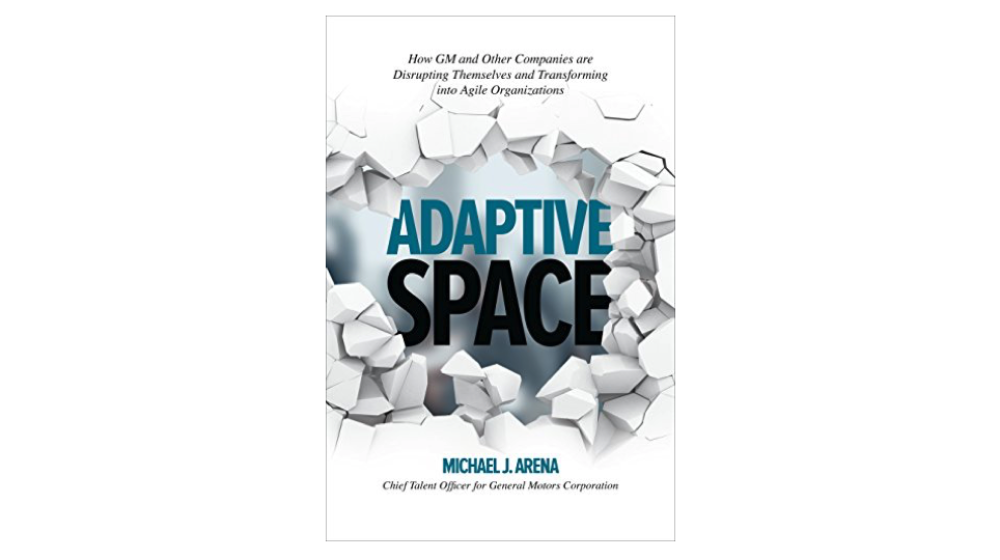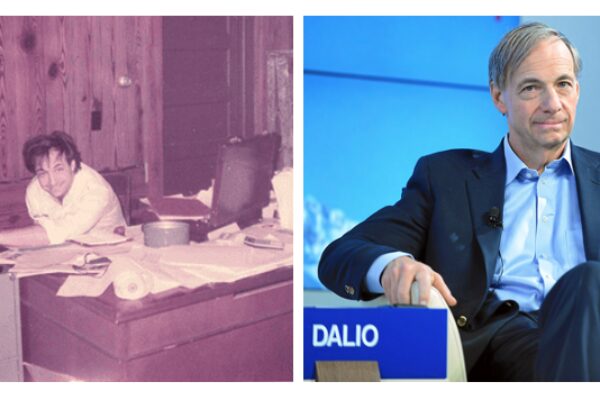
Entrepreneurial activity happens in pockets. Whether the spark of an advance gets lit in an inventor’s garage, in the “15 percent time” of a 3M engineer, in a strategist’s conference room, or next to the fancy espresso machine of a well-funded Silicon Valley insurgent, the advance starts off to the side of the big moving gears of how the world operates today.
In order for innovation to achieve results, it needs to hook into these moving gears. In the space between the entrepreneurial pockets and the big moving gears, fortunes are secured and dreams fall away. But how does one master this space between, in which the work is so different from the work of invention, on the one hand, and so different from the work of operating at scale, on the other?
Michael Arena’s new book, Adaptive Space, is the best examination of this pivotal question I’ve yet encountered. Michael brings together in a rare way the virtues of the scientist, the engineer and the executive. He’s worked at the cutting edge of applying the science of networks to organizational performance. He’s collaborated with the best minds in that field, like Rob Cross, who was for a while a Senior Fellow at Katzenbach Partners and taught me much of what I know about networks. He spent two years as a visiting scientist at MIT Media Lab, and is attuned to how technology can expand the ways ideas travel and collaboration unfolds. But most of all, Michael is a believer in the capacity of big companies, if they operate right, to drive innovation at scale – and in his role as Chief Talent Officer at General Motors, he’s playing a critical part in proving out that GM can play a central and profitable role in shaping the future of transport.
Michael’s work begins from the recognition that GM has capabilities that Tesla, Uber and Apple – to take three – do not have and cannot rapidly build. If GM can solve the organizational questions of how to connect the right dots, bring innovators into its system in ways that accelerate their impact, and avoid the friction losses that so often hold incumbents back, it can outcompete even the most ambitious of the new entrants. Solving these organizational questions isn’t a matter of optimizing the lines and boxes of the formal organization, but must be accomplished in the fluid, messy, human space of the informal organization.
Perhaps the most important message of our work at Katzenbach Partners was that organizational performance is shaped in the informal organization. While Jon Katzenbach and Zia Khan’s book on informal organization, Leading Outside the Lines, stands the test of time, Michael’s work on adaptive space represents an important advance beyond that early work, an advance in both theory and practice. I’ll summarize here what I believe that advance to be and why I believe it matters so much. There’s much, much more richness in Michael’s book – I’m simply making the case for reading it and actively practicing the disciplines that Michael writes about, to the point where they can become second nature, simply a part of how you get results.
Of all the many aspects of informal organization, Michael focuses on adaptive space, which he defines in an earlier essay as “any environment that creates an opportunity for ideas generated in entrepreneurial pockets of an organization to flow into its operational system.” Think of adaptive space as the middle zone between entrepreneurial pockets and the operational system of how an organization operates at scale; one of the analogies Michael uses in the book is to the tidal pools at the border of land and sea that nurture so many kinds of life.
Discoveries often combine two or more ideas born in different contexts to create a new solution. It is intuitive that what network scientists call brokers – people who have relationships that span two distinct communities – play a critical role in the discovery process. Michael explores this pattern, and provides useful ideas about how to be more systematic about finding, making and supporting brokers. Where the work on Adaptive Space is most distinctive, though, is in the examination of how networks should operate after discovery: though the process of development by which an invention becomes a solution; the process of diffusion in which an idea gains the broad currency of support inside an organization required to scale successfully; and the process of disruption by which a new solution is formalized in the organization’s operational system, replacing earlier approaches. Distinct aspects of networks are critical to each of these stages, making the sport of driving value from innovation like a quadrathlon, with the overall result a function of being able to compete successfully in the four Ds of discovery, development, diffusion and disruption.
Discovery flourishes in a space of divergent connections and possibilities. Development requires hunkering down and intense focus on the specific “how to” problems on the critical path to making a solution compelling. From a network perspective, while brokers who connect disparate groups are central to innovation, successful development requires something different: sustained focus from highly cohesive groups (think of the “two pizza” teams Jeff Bezos celebrates at Amazon). Cohesive groups naturally run the risk of isolation, getting stuck in their silos. The best offset to this risk is to have a small number of “central connectors” who can reach across organizational boundaries to resolve issues and get things done.
I’ll quote at length Michael’s application of these concepts to one of the world’s highest-stakes challenges of making innovation stick, GM’s billion-dollar acquisition of the driverless car start-up Cruise Automation.
One of the problems when a large corporate giant acquires a start-up is that the synergies that drove the acquisition dissipate quickly. The swift, entrepreneurial nature of the start-up then collides head-on with the operational systems and politics of the slow-moving, risk-averse larger corporation. Soon after, the start-up loses its mojo and the founder’s passion begins to feel more like a job. But GM intentionally structured the Cruise deal to minimize this effect…. [Adaptive space] enables Cruise to remain densely cohesive with intentional development connections to drive fast progress while building brokerage bridges to the core of GM.
… Doug Parks, GM’s vice president for autonomous technology and vehicle execution, describes it as a “give and take” model. He says, “They’re focused on getting two to three cars to work, and we’re focused on getting 20,000 to 30,000 cars to work.” This embedded tension enables both groups to quickly discover, develop, and ultimately commercialize a self-driving car at scale.
In this space, Parks is the broker and [Cruise founder Kyle] Vogt is the fiercely focused central connector. Because the core of GM isn’t designed to move fast, Adaptive Space helps bridge the differences so GM and Cruise can learn from each other while continuing to leverage what each does best. For example, Parks’s team has abandoned the daily staff meeting, where everyone reviews projects, and instead implemented a Cruise-like daily 15-minute blitz to discuss daily challenges that need to be solved. The result has been accelerated decisions within 24 hours. Meanwhile, Cruise gets to enjoy the benefits of GM’s experienced engineering expertise and access to testing facilities. Parks and his team act as a bridge to the core engineering team when something needs fixing on one of Cruise’s modified Chevy vehicles. Rather than spending hours trying to figure something out, the self-driving start-up team members are able to connect with the parts engineer to resolve it quickly and get back to doing what they do so well – working on the algorithms for self-driving. With Parks serving as the broker, Vogt is able to work exclusively as the central connector, thus keeping his team focused on one thing, “the plan” to get self-driving cars on the road.
This represents a delicate dance in the “tidal pools” between an entrepreneurial pocket – Cruise had a team of fewer than fifty when GM acquired them – and one of the world’s largest enterprises. Too little integration and a deal like this creates friction loss with little upside; too much integration will almost always snuff out the magic of the entrepreneurial venture. Achieving the sweet spot in between requires that just the right bridges must be built in Adaptive Space.
The work of development is essentially introverted – intense, heads-down focus on problems that must be solved. Success in this work earns entry into the next event in the quadrathlon, diffusion: how an idea gains the momentum and traction in the operational system required to achieve impact at scale. This work of diffusion is the extraverted mirror image of the introverted development process: success hinges on ambassadorship and bridge building. In his chapter on diffusion, Michael shares some of the techniques that GM has used, such as Tipping Forward events that bring 300 to 600 people together “to openly share the many successes that have been applied locally and to then tap into the passion of energizers to amplify these successes across the broader enterprise.” Back at Katzenbach Partners, one of our signature approaches was to push what Michael might have called “design for diffusion” to the very front end of the problem solving process. In an engagement with Shell, for instance, we tackled the imperative to improve productivity in refineries by identifying what we called pride builders – Michael would call them energizers – and engaging them in problem solving about how to overcome barriers. These individuals were natural connectors, informal leaders who could rapidly shift the day-to-day texture of “how things get done” once they’d generated insights about how things could work better. While in a sense we had no business competing with firms like McKinsey for this work – we freely acknowledged we lacked substantive expertise in the running of refineries, which McKinsey’s team had in spades – the successful bet that we and Shell made together was twofold:
- pride builders with deep bonds of trust with their peers could, with the right tools and support, get to the heart of what needed to change faster than outsider-experts;
- results would flow faster and better if front-line engagement was at the core of the work from the beginning, rather than approached through the lens of “change management” once a solution was already in place.
Successful diffusion drives the uptake that begins to scale a new idea. For a while, “new” and “old” will often live side by side. During this period of diffusion, the action is concentrated in the informal organization. Adoption needs to be earned laterally. Top management support can be an enabler, but change can’t be driven comprehensively from the top down. There are simply too many moving pieces, and “answers” haven’t yet been developed to the level that a linear, programmatic approach will succeed. As diffusion succeeds, however, organizations face the more radical choice of whether to substitute the “new” for the “old.” This is the stage that Michael refers to as disruption, and here the action shifts from the informal organization to the formal organization. Top leaders need to embrace the role of the challenger.
Brokers discover ideas, connectors develop them, and energizers diffuse them. Challengers, on the other hand, provoke positive disruption to usher in new ideas as the new normal. They ignite change from within an organization by leveraging external pressures as catalysts for change. They enable agility by positively disrupting the status quo and breaking down barriers to progress.
While nearly all top executives use “challenger speak,” in our experience relatively few have figured out how to effectively play the sponsor role with innovation functions or with entrepreneurs on the inside. They aren’t ready for the shifts required of them as the action moves from discovery to development to diffusion to disruption. They haven’t come to an understanding of the distinct disciplines associated with each stage that enable them to foster the critical networks and evolve their own role to what each “event” requires.
Much of Michael’s focus inAdaptive Space is on the inside of large enterprises, which reflects both his position as GM’s Chief Talent Officer and his belief that the innovation potential of giants is underappreciated and the disruptive power of entrants often oversold. Reflecting on Michael’s book has made me aware of how much of Incandescent’s work hinges on creating the right adaptive space between and among organizations.
In our work to create and build companies, success often hinges on shaping adaptive space in which an entrepreneurial venture drives development and diffusion in partnership with larger enterprises. For instance, consider Skreens, one of our portfolio companies that has developed and patented technology that can function as the operating system for the world that Corning painted so vividly years ago in their video “A Day Made of Glass.” Skreens’ software can power a sports broadcast in which one can personalize their viewing experience with multiple games, fantasy stats, a Twitter feed and a gaming feed from Twitch, all sized and shaped as one wishes on a single large screen. It can power a security professional’s ability to see on a single screen a filtered set of camera feeds that a machine learning algorithm flags as needing human attention, with contextual information under each video. We’re still a small company, and our success will depend on creating adaptive space in which we can partner, both with small numbers of innovators and ambassadors in large enterprise partners, such as Xilinx – a semiconductor partner and strategic investor in Skreens – and with the big players who can harness our technology to enhance their digital products and services in fields like media, healthcare and security. We must design the collaboration in these adaptive spaces to lock into the big gears in the operational systems of these partners, to scale beyond powerful proofs of concept, and to influence fundamental thinking about their product roadmaps. If we have to do all the work of engaging the operational system of big enterprises ourselves, we’ll be swamped. If we stay in our entrepreneurial pocket, we’ll never achieve scale. By building the right networks and the right collaboration in the adaptive space between – for instance, between Skreens and Xilinx – we can stay lean and fast even as we position ourselves to achieve great reach.
The challenges of shaping adaptive space between and among organizations is equally central to the work we do driving systems change in the social sector. While there have been great advances in the field of sexual and reproductive health, for instance, adolescents in regions such as East Africa and South Asia have been persistently hard to reach and engage. The application of human-centered design by innovation firms such as IDEO.org working in partnership with large implementer NGOs such as Marie Stopes International has demonstrated early promise. Still, simple linear extrapolation of the rate of innovation and the rate of scaling achieved by early demonstration projects would take far longer to yield the level of impact that funders and the NGOs active in this space aspire to. Bending the curve of the rate of development of this field requires creating an adaptive space in which different kinds of actors can channel resources to the points of greatest leverage, figure out how to overcome a range of barriers, and ensure the whole of their efforts add up to much more than their programmatic parts. Entrepreneurial pockets – e.g., a small team in a design firm hatching a new idea for how to engage adolescents – are essential but insufficient. New solutions need to mature before they can be adopted at scale by the operational systems of implementer NGOs. Years of development and diffusion work need to be guided, nurtured and sustained – with the potential to positively impact millions of lives.
These patterns in our own work stand out more clearly in the bright, clear light of Michael Arena’s Adaptive Space. A great many of the advances that matter most, both in business and society, depend on effective execution of the nuanced work of making innovation stick. This work, made or broken in the adaptive space inside large enterprises and among constellations of different actors, cannot be reduced to a formula. It can, however, be mastered through clear thinking and discipline. Adaptive Space takes an important step in showing us the way.



